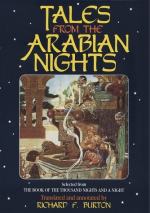[FN#44] In the text “Argha” for “Arkha"=he “brayed” (like an ostrich, etc.) for “his limbs relaxed.” It reminds one of the German missionary’s fond address to his flock, “My prethren, let us bray!”
[FN#45] Arab. “Azbad,” from Zbd (Zabd)=foaming, frothing, etc., whence “Zubaydah,” etc.
[FN#46] Arab. “Zabh” (Zbh)=the ceremonial killing of animals for food: see vols. v. 391; viii. 44. I may note, as a proof of how modern is the civilisation of Europe that the domestic fowl was unknown to Europe till about the time of Pericles (ob. B.C. 429).
[FN#47] See in “The Forty Vizirs” (Lady’s ivth Tale) how Khizr tells the King the origin of his Ministers from the several punishments which they propose for the poor man. I have noticed this before in Night cccxxxiii. Boethius, translated by Chaucer, explains the underlying idea, “All thynges seken ayen to hir propre course and all thynges rejoysen in hir returninge agayne to hir nature.”
[FN#48] For the Taylasan hood see vol. iv. 286.
[FN#49] The “Kalansuwah"-cap is noted by Lane (A. N. chapt. iii. 22) as “Kalensuweh.” In M. E. (Supplement i. “The Copts”) he alters the word to Kalas’weh and describes it as a strip of woollen stuff, of a deep blue or black colour, about four inches wide, attached beneath the turban and hanging down the back to the length of about a foot. It is the distinguishing mark of the Coptic regular clergy.
[FN#50] W. M. Ms. vol. iii. pp. 121-141. Scott, “The Adventures of the abdicated Sultan,” pp. 18-19; including the “History of Mahummud, Sultan of Cairo,” pp. 20-30.
[FN#51] “Kahirah.” I repeat my belief (Pilgrimage i. 171) that “Kahirah,” whence our “Cairo” through the Italian corruption, means not la victorieuse (Mediant al-Kahirah) as D’Herbelot has it; but City of Kahir or Mars the planet. It was so called because as Richardson informed the world (sub voce) it was founded in A.H. 358 (=A.D. 968) when the warlike planet was in the ascendant by the famous General Jauhar a Dalmatian renegade (not a “Greek slave”) for the first of the Fatimite dynasty Al-Mu’izz li ’l-dini ’llah.
[FN#52] According to Caussin de Perceval (pere) in his translation of the “Contes Arabes,” there are four wonders in the Moslem world: (1) the Pharos of Alexandria; (2) the Bridge of Sanjia in Northern Syria; (3) The Church of Rohab (Edessa); and (4) the Amawi Mosque of Damascus.
[FN#53] Arab. “Faddah,” lit.=silver, because made of copper alloyed with nobler metal; the smallest Egyptian coin=Nuss (i.e. Nusf, or half a dirham) and the Turk. parah. It is the fortieth of the piastre and may be assumed at the value of a quarter-farthing.
[FN#54] This word, in Egypt. “Harag,” is the cry with which the Dallal (broker) announces each sum bidden at an auction.
[FN#55] The Portuguese Xerafim: Supplemental Nights, vol. iii. 166.




